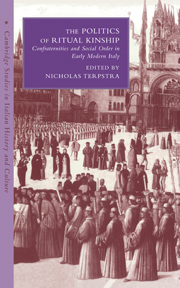Book contents
- Frontmatter
- Contents
- List of Contributors
- Acknowledgments
- Introduction The Politics of Ritual Kinship
- 1 The development of confraternity studies over the past thirty years
- 2 Homosociality and civic (dis)order in late medieval Italian confraternities
- 3 Confraternities and lay female religiosity in late medieval and Renaissance Umbria
- 4 The bounds of community: commune, parish, confraternity, and charity at the dawn of a new era in Cortona
- 5 Men and women in Roman confraternities in the fifteenth and sixteenth centuries: roles, functions, expectations
- 6 The Medici and the youth Confraternity of the Purification of the Virgin, 1434–1506
- 7 In loco parentis: confraternities and abandoned children in Florence and Bologna
- 8 The first Jesuit confraternities and marginalized groups in sixteenth-century Rome
- 9 Jewish confraternal piety in sixteenth-century Ferrara: continuity and change
- 10 The scuole piccole of Venice: formations and transformations
- 11 Relaunching confraternities in the Tridentine era: shaping conscience and Christianizing society in Milan and Lombardy
- 12 The development of Jesuit confraternity activity in the Kingdom of Naples in the sixteenth and seventeenth centuries
- 13 Corpus Domini: ritual metamorphoses and social changes in sixteenth- and seventeenth-century Genoa
- 14 Faith's boundaries: ritual and territory in rural Piedmont in the early modern period
- 15 The suppression of confraternities in Enlightenment Florence
- Bibliography
- Index
- CAMBRIDGE STUDIES IN ITALIAN HISTORY AND CULTURE
9 - Jewish confraternal piety in sixteenth-century Ferrara: continuity and change
Published online by Cambridge University Press: 02 October 2009
- Frontmatter
- Contents
- List of Contributors
- Acknowledgments
- Introduction The Politics of Ritual Kinship
- 1 The development of confraternity studies over the past thirty years
- 2 Homosociality and civic (dis)order in late medieval Italian confraternities
- 3 Confraternities and lay female religiosity in late medieval and Renaissance Umbria
- 4 The bounds of community: commune, parish, confraternity, and charity at the dawn of a new era in Cortona
- 5 Men and women in Roman confraternities in the fifteenth and sixteenth centuries: roles, functions, expectations
- 6 The Medici and the youth Confraternity of the Purification of the Virgin, 1434–1506
- 7 In loco parentis: confraternities and abandoned children in Florence and Bologna
- 8 The first Jesuit confraternities and marginalized groups in sixteenth-century Rome
- 9 Jewish confraternal piety in sixteenth-century Ferrara: continuity and change
- 10 The scuole piccole of Venice: formations and transformations
- 11 Relaunching confraternities in the Tridentine era: shaping conscience and Christianizing society in Milan and Lombardy
- 12 The development of Jesuit confraternity activity in the Kingdom of Naples in the sixteenth and seventeenth centuries
- 13 Corpus Domini: ritual metamorphoses and social changes in sixteenth- and seventeenth-century Genoa
- 14 Faith's boundaries: ritual and territory in rural Piedmont in the early modern period
- 15 The suppression of confraternities in Enlightenment Florence
- Bibliography
- Index
- CAMBRIDGE STUDIES IN ITALIAN HISTORY AND CULTURE
Summary
Shortly before the Jewish New Year of 1515, fifty-seven men and fourteen women gathered together in the synagogue of Ferrara's then still modest Jewish community in order to form, with the consent of the latter's leadership, a pious confraternity which was evidently the first of its kind among Italian Jewry. The synagogue in which they met had been established in the 1480s in a building which had been given to the community for that purpose by Ser Samuel Melli of Rome, who had purchased it from a member of the Norzi family, Ferrara's leading Jewish banking family. The conversion of the building into the first permanent place of worship for the members of Ferrara's Jewish community had been authorized by Duke Ercole I of the House of Este, which had generously (and sometimes bravely) been extending protection and support to both resident and refugee Jews since the middle of the fifteenth century. In 1473 Ercole I had extended such protection to resident Jews in opposition to papal demands, and two decades later he allowed twenty-one families of Spanish exiles to settle in Ferrara under rather favorable conditions. This policy had been reaffirmed by his son, Alfonso, in 1506. Ferrara, in the early sixteenth century, was a modest sized, though fairly heterogeneous Jewish community, which despite periodic tensions with the local Christian populace, had benefited from unusually good relations with the ruling dynasty.
The Gemilut Hasadim (hereafter GH) society founded there is the earliest Italian Jewish confraternity whose documentation has survived.
- Type
- Chapter
- Information
- The Politics of Ritual KinshipConfraternities and Social Order in Early Modern Italy, pp. 150 - 171Publisher: Cambridge University PressPrint publication year: 1999



